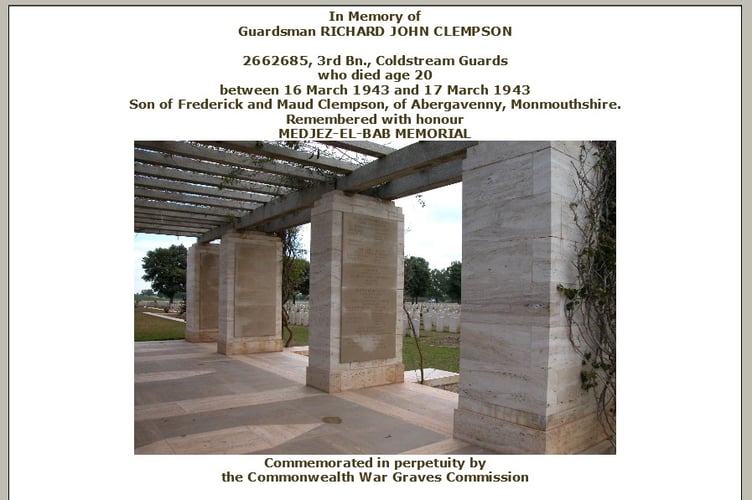HE was just an ordinary lad; a younger brother to my mother, the only son of my grandparents. He didn’t much care for school and sometimes skived off, according to his sister. He left at 16, and despite any misdemeanours, his headmaster wrote well of him on conscription to the army.
When the war came, he signed up, though by then he was in a reserved occupation in The Wiltshire Constabulary, as a clerk. Having disliked school it was little wonder that when he came of age, he left behind his work of a clerk for the lure of adventure in the armed forces. After only four months of being posted to the field and seeing six weeks of active service he gave his life for his country and my grandparents received the dreaded telegram: MISSING IN ACTION, PRESUMED DEAD. Then came the official confirmation: KILLED IN ACTION.
My grandmother never recovered from this and would not open another telegram for the rest of her life.
My Uncle John, whom I never met, was nearly six feet tall, with fair hair and blue eyes, and, at nineteen, must have cut a dashing figure, especially in his uniform. Until I read his records I did not know from where I inherited the colour of my own hair and eyes, as well as my height, and often wondered what it would have been like to have had an uncle and possibly cousins on my mother’s side.
All we knew of John’s war was that he was in the Coldstream Guards in various places in the South of England and had been killed in action in Southern Tunisia on the night of 16th/17th. March 1943. His service records show where he was posted, but it was the re-emergence after sixty years of two letters written to my grandparents by members of his battalion after his death, which enabled the details of his short war and death in Tunisia to be pieced together.

Richard John Clempson was the only son of Mrs. Maude and Mr. Frederick Clempson of 67 Frogmore Street, Abergavenny. He was born in 1921, just less than two years after his older sister, Kathleen. On 16th July 1940, he was recruited by the Abergavenny recruitment office and accepted through the Newport Recruitment centre. According to his enlistment papers he declined any other regiment except for the Coldstream Guards. Kathleen said it was the busby which attracted him and the ceremonial duties performed by the regiment at Buckingham Palace. During their home service, the Coldstream Guards were the Royal Protectors, but this duty and privilege fell to a selected elite.
Instead, classified as A1 medical fitness, he spent time in training and holding battalions before entering the first cohort of the 6th Brigade when it was set up on 24th October 1941. This was in Harrow-on-the Hill then in Middlesex, and itself became a holding battalion. Years later, when my father’s job took him from Neath to Acton in West London, we lived in Eastcote in Middlesex where it appeared that John had been billeted, and where he probably frequented the Clay Pigeon Pub, which my sister and I passed daily on our way to Field End Primary school. I didn’t realise at the time, but now I think going there was something of a spiritual reunion for my mother with her only brother.

John’s call overseas was in December 1942 when he was posted to Egypt, and, after landing at the end of January 1943, waited to be joined into a battalion. On 9th. February 1943 the 3rd battalion of the Coldstream Guards in the 201st Battalion of the 8th army swept him and many others into their ranks and proceeded through Syria to Tunisia for the final assault on the enemy in the Campaign in North Africa.
According to military sources John would have encountered minor skirmishes moving through Syria, and into Tunisia, until his first major battle at Medenine on 6th March 1943, when his battalion was attacked by the enemy line. One account records how 3rd Battalion was always on the move and may have moved 72 times during their first four months in Tunisia alone, “moves, all undertaken in the dark, many of them resulting in fierce fighting.”
Ten days later they advanced on the enemy’s defences at Mareth. Preparation for General Montgomery’s main assault on the Mareth Line, Operation Pugilist, which was planned for 20th March, included taking a strategic hill, the Horseshoe Ridge, in advance. On the night of 16th to 17th March 1943, the operation began, but the enemy was ready for the Allied forces. A gunner with papers on him detailing the plans, had been captured by the enemy two days previously, and as a result they had strengthened their position.
As the assault commenced it was difficult for the infantry to keep on course through the gunfire smoke, and backup vehicles could not scale the sheer vertical banks of the Wadi facing the British lines, which ranged between three and thirty feet in height. The short time between arrival of the troops at the starting point and the operation itself limited the collection and analysis of military intelligence. Interpretation of aerial photographs had failed to note the intensity of minefields, which, according to the Royal Engineers, were thickly laid as to be almost touching. One could imagine John seeing his comrades blown into the sky or felled like trees on the earth as he advanced into certain death himself.
Over thirty-eight officers and five hundred guardsmen were killed in Operation Walk on the Horseshoe Ridge that night. In John’s battalion, ten officers and a hundred and twenty-six guardsmen, of whom he was one, were gunned down or blown up.
“Your son was killed instantaneously & without any pain at all by a land-mine & I am sure you will be comforted & relieved to hear he did not suffer. It was during a night attack by moonlight on a strong German mountain position at Mareth.” wrote Lt. Phipps, John’s platoon commander.

Johnathan Forbes, a former Grenadier guard, whose father’s battalion, the 6th. Grenadier Guards, fought alongside that of John, visited the killing fields 64 years after the event.
“As I gazed down from the summit of Sidi-el-Guleaa, it was easy to imagine the steel-helmeted guardsmen in their battle dress, many wearing leather jerkins as limited protection against anti-personnel mines, moving through the terrifying inferno of that night, a night where, in the noise, smoke and uncertainty of battle, confusion reigned supreme.”
Despite General Montgomery declaring the operation a victory (“tell the men this”), either to save his face, or because many enemy soldiers were also lost, other senior officers were distraught to think that the ferocity of the minefield had escaped their military intelligence. Accounts at the time mentioned one officer at the drumhead service with tears streaming down his face.
Lt. Phipps, in his letter, tried to soften the blow to my grandparents and to shroud John in glory.
“Your son was a nice, cheerful, agile & efficient fellow & one whom I was delighted to have in my platoon. It was a good and happy platoon & we had quite a lot of fun together.
“Your son died as a soldier should, in battle & on the attack. There is no more glorious end than that for any of us. And although in the bitterness of the event it seems cold comfort, I am sure you must be proud to know that he died fulfilling his duty to the last.”

It would be comforting to think that John had died in the glorious service of his country, but the reality was far from glorious. In fact it was carnage that never should have happened in a minefield the likes of which the Royal Engineers reportedly had never seen.
Young men were sent to the slaughter by commanders whose intelligence had failed to recognise the intensity of the minefield or the reinforcements garnered by the enemy. They had little back-up from the armoured cover which could not scale the steep escarpment and could not move in the wadi for fear of being blown up by the mines, as some were. The operation was consequently doomed to failure.
Instead, a mother and father lost their only son at 21 years of age. A sister lost her brother. 136 mothers and fathers lost their sons in the Coldstream Guards that night, as did more than 200 mothers and fathers of sons in the 6th battalion of the Grenadier Guards leading the assault on that night.
It is not known where John’s remains are buried. Likely it was in the killing field in the Wadi or on the ridge. Diaries of Operation Recovery the next day described it being especially difficult to collect the
wounded and to bury the dead, such was the carnage. Seven hundred and twenty mines had to be removed in order to retrieve sixty-nine bodies all piled up, most of whom were then buried in a roadside grave.
R.J. Clempson, “Uncle John” is commemorated on the Abergavenny and District War Memorial, at the MEDJEZ-EL-BAB MEMORIAL in Tunisia, through the Commonwealth War Graves Commission, and at the police station in Devizes where he had worked until he enlisted.






Comments
This article has no comments yet. Be the first to leave a comment.